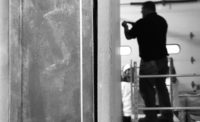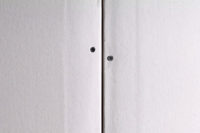A couple of weeks ago, when I was stuck in morning traffic, I started flipping through satellite radio channels. By chance, I happened across the Eminem and Rhianna song “Love the Way You Lie.” She has a beautiful voice, and he can really add an edge to a song, but being a guy who is still mourning the break-up of the Ramones, it’s not really my style of music, so I had largely ignored the song in the past.
Rhianna song “Love the Way You Lie.” She has a beautiful voice, and he can really add an edge to a song, but being a guy who is still mourning the break-up of the Ramones, it’s not really my style of music, so I had largely ignored the song in the past.
For the first time I listened to the lyrics, and there it was: Pow! To my surprise, Eminem actually uses the word “Drywall” in the lyrics of “Love the Way You Lie,” when he says, “… I’ll aim my fist at the drywall.”
I doubt Mr. Mathers (Eminem) is looking to take my phone call, however this got me thinking, if were I to speak with him, my advice would be simple: Moving forward, be careful what drywall you slug. For I don’t think he wants to go toe-to-toe with a sheet of abuse- or impact-resistant board. These new products are tough, and they are coming into the marketplace in a big way. He might slug something that looks like drywall, and it might fight back.
THE PANELS
I first recall seeing impact-resistant gypsum panels 12 to 15 years ago. While the product gained some early acceptance, overall use was handicapped, in my opinion, due to the lack of a standardized, comparative test method. The panels were tough, but without some type of comparative benchmark, an architect or building owner couldn’t evaluate the new products against traditional materials such as masonry.
The test method situation was resolved within the past half-decade by the creation of ASTM C1629, Standard Classification for Abuse-Resistant, Non-decorated, Interior Gypsum Panel Products and Fiber-Reinforced Cement Panels. While the initial impetus for creating the standard was to facilitate a comparison to masonry systems used in stairway or elevator shafts, it has evolved to the point where it is now used to compare dissimilar materials in a variety of building applications.
Most commercial and institutional buildings have high-traffic areas where many people move through a building. Such areas include lobbies, hallways, corridors, and stairways. As people travel through these areas they are likely to be carrying or transporting objects that bump into and scrape the surfaces of the surrounding areas.
Wall surfaces in these areas are inherently more prone to daily wear and tear compared to wall surfaces in areas usually occupied by just a few people. If the materials used to construct the walls in these areas are not more durable than the materials suited for normal use, the condition of the walls quickly becomes an issue. The building owner must either live with an increasingly shabby appearance of the building or commit additional resources to maintaining the building’s appearance.
Often this is not merely an issue of cosmetic distress. Gouges, tears, and dents in the surface of wallboard can affect the overall fire-resistance and sound attenuation characteristics of a gypsum-clad partition system. In today’s marketplace, design professionals and building owners have several options to choose from when providing durability and fire-resistance. It is in these locations where abuse- and impact-resistant materials are finding their niche.
RESISTANCE TESTING
Different manufacturers use varied technologies to provide abuse and impact resistance to the gypsum panel products they offer. The C1629 standard provides a method to evaluate the performance of different panel materials. Using laboratory test methods, the standard provides three classification levels in four different categories.
The first category is Surface Abrasion Resistance, which is determined using a surface abrasion test. A weighted scrub brush is passed 50 times across the surface of a sample and readings are taken to determine how deeply the brush has penetrated the surface. The panel is classified on a scale of 1 (lowest resistance to abrasion) to 3 (highest).
The second category, Indentation Resistance, is measured using an indentation test. The test measures the impression left in the test sample’s surface by a spherical projectile. Similar to the Surface Abrasion Resistance test, materials are classified on a scale of 1 to 3, with 3 being the highest classification.
Two different tests are used to determine the soft body and hard body impact resistance of a sample in the third and fourth assessment categories. Soft body impact resistance is determined by swinging a weighted bag at a sample until structural failure of the sample occurs. The distance of the bag “drop” is then measured and classified. The hard body impact test is measured using a weighted ramming arm. Weight is progressively added to the arm until penetration occurs. The sample is tested until failure and then classified. As with the two previous tests, materials are classified on a scale of 1 to 3.
Panels can be singularly abuse- (abrasion) or impact-resistant, or they can display both attributes. In many instances, the required attribute is a function of panel use and the point of installation. For example, panels in a shaftwall system in a high-rise building might need to be highly impact-resistant to meet code requirements; however, they may be installed in a concealed location and not need to be abuse-resistant. The opposite scenario may also be the case.
One attribute of abuse- and impact-resistant gypsum panel products—and this is where Eminem needs to be careful—is that when finished and painted, they often look like painted conventional drywall. As a result, a building occupant has no knowledge of the additional attributes of a panel until an abuse or impact event occurs. This would include an attempt to puncture a panel with a fist.
PRODUCTS AVAILABLE
Abuse- and impact-resistant products are generally of three types: paper-faced boards and panels with specially engineered paper facings and densified cores; glass mesh-faced boards and panels with densified cores; and unfaced panels. Each manufacturer offers product literature describing its selection of abuse- and impact-resistant panels. The literature includes the test results of the applicable ASTM C1629 testing to which the panels have been subjected.
Additional information is available from the individual panel manufacturers or in the Complimentary Brochures section of the Gypsum Association website. All may be accessed at: www.gypsum.org W&C






